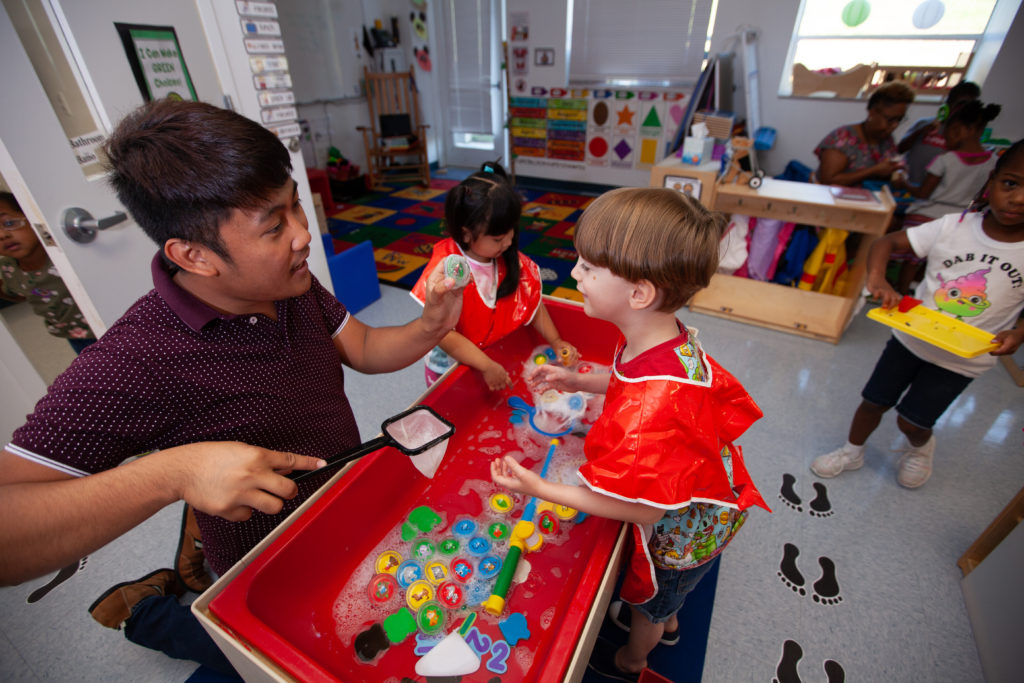If any issue warrants public attention, public discussion and rethinking as to the best way to ensure families with young children have access to child care and pre-kindergarten, it is our nation’s current approach to the safety and healthy development of young children. It’s not a system as much as a patchwork quilt stitched together over decades. The federal government allocates funds to states through individual programs or funding streams (i.e., block grants), each with different rules, administered by different state agencies, and too often resulting in siloed approaches with little to no coordination or collaboration among state agencies, departments, divisions or communities.
In December 2019, Congress enacted the FY2020 Labor, Health and Human Services and Education Appropriations measure, which included the following funding levels for early care and education programs:

In addition to the funding above, in FY2019, the U.S. Dept. of Agriculture allocated $3.7 billion to states to support healthy meals and snacks for low-income children in child care centers and family child care homes [1] and the U.S. Dept. of Health and Human Services allocated the Temporary Assistance for Needy Families (TANF) block grant to states, of which states chose to use $3.8 billion for child care and $2.6 billion for state pre-K. [2] The number of children served by TANF funds for child care or pre-K is unknown because the federal government only requires aggregate spending to be reported, not how many children are served, the setting children are in (homes or centers, licensed or unlicensed) or the average price paid per child. In all, that’s more than $35 billion through various federal funds for early care and education programs.
Child care is the largest early childhood program with $12.5 billion in funding and yet only about 17 percent of eligible children (based on state standards) receive a subsidy. [3] Many states have a waiting list for assistance, including North Carolina with a waiting list of more than 40,000 children. Families have a difficult time finding care, affording care, and then many parents express concern about the quality of care. Numerous national reports have been released about child care deserts, communities where the need for child care for parents of children under age 6 pales in comparison to the licensed supply of child care. [4] The U.S. Dept. of Health and Human Services released a report in October 2019 that found the supply of home-based care has declined by more than 97,000 providers since 2005. [5]
Why? Child care is a business. Child care centers tend to operate in areas where the population is dense enough with sufficient numbers of private-pay families who can afford weekly parent fees. The operating budget for child care centers largely comprises parent fees and therefore staff is hired at the lowest wages possible to hold costs down. In a good economy with low unemployment, like we have today, turnover is high because staff often can find better-paying jobs in fast food, retail sales or other jobs that require less training or education. Turnover also costs businesses because of the marketing, interviewing, hiring and training required for new staff.

For home-based providers, the hours are long and the pay is low. According to a 2019 economic impact report by the Committee for Economic Development, [6] the average annual income of home-based providers is approximately $15,000 per year, [7] 18% higher than in North Carolina, where the average income of home-based providers is $12,300. [8] The decline in home-based providers (who often serve infants and toddlers) is a hardship for parents, particularly those in rural communities where the economics of operating a center don’t work. Home-based care is often less expensive and providers may be more willing to stay open during nontraditional hours for those parents who work shift work or have long commutes to their job. Yet, again, wages drive interest in opening a home-based program (or closing one) because other jobs in the community may pay more with fewer hours and less stress.
The reality is that mothers are working today. Nationally, approximately 72 percent of mothers with children under age 6 are working outside of the home, [9] 65.4 percent of mothers with children age 2 are working [10] and, 57.8 percent of mothers with children under age 1 are working. [11] Many of these mothers need child care, but federal subsidies reach only one out of every six eligible children. Therefore, most families are forced to afford whatever they can find. However, in too many communities, the supply is not available, let alone affordable.
There is no doubt that if our nation’s early care and education system were designed today, it would look much different. If we can’t think out of the box about a new bold system to better meet the needs of families with young children, we will be stuck with incremental, minor band-aids that ignore the real problem: the system is under-financed and poorly designed. Parents can’t afford quality child care, but we know from the research that high-quality child care really matters to the healthy development of children, particularly in the earliest years as a child’s brain is developing the fastest, setting the architecture for all future social, emotional, physical and cognitive skills. [12]
Two decades ago, child care was a work support. Today, we know that it is a two-generation strategy. High-quality child care helps parents work and helps support the healthy development of children. In fact, parents who can’t access child care reduce their hours or drop out of the workforce. About 94 percent of those who involuntarily work part-time are mothers who cite child care problems as their reason for working part-time. [13]
In 2018, the National Academy of Sciences (NAS) released “Transforming the Financing of Early Care and Education,” which reviewed the multiple funding streams for early care and education and made a number of recommendations. The NAS Committee, made up of early childhood experts and finance experts, recommended investing in early care and education at a percentage of U.S. gross domestic product (GDP) aligned with the average of other member nations of the Organization for Economic Co-operation and Development (OECD). The report recommended increasing funds in four phases, from at least $5 billion in phase one to $53 billion in phase four. [14]
However, it is not just about the money. It is also about program design and meeting the needs of families in urban and rural areas and in an array of settings that best meet the needs of the family and each individual child with an early education workforce that is trained and paid appropriately for the important work they do.
Rethinking is always a
bit more challenging than staying in the box with patchwork fixes. The current
system isn’t working for low-income children whose families need a subsidy or
the private market where working parents need access to affordable high-quality
child care and early education programs. It is time for a discussion about a
redesign.
[1] U.S. Department of Agriculture, Child and Adult Care Food Program, January 2020. https://fns-prod.azureedge.net/sites/default/files/resource-files/ccsummar-1.pdf
[2] U.S. Department of Health and Human Services, Office of Family Assistance, TANF expenditures FY2018. https://www.acf.hhs.gov/ofa/resource/tanf-financial-data-fy-2018
[3] U.S. Government Accountability Office (GAO), Child Care: Access to Subsidies and Strategies to Manage Demand Vary Across States, 2016. https://www.gao.gov/assets/690/681652.pdf
[4] Center for American Progress, https://www.americanprogress.org/issues/early-childhood/reports/2018/12/06/461643/americas-child-care-deserts-2018/; Child Care Aware of America, https://www.childcareaware.org/our-issues/research/mappingthegap/.
[5] U.S. Department of Health and Human Services, National Center on Early Childhood Quality Assurance, 2019. https://childcareta.acf.hhs.gov/sites/default/files/public/addressing_decreasing_fcc_providers_revised_final.pdf
[6] Committee for Economic Development of The Conference Board, Child Care in State Economies: 2019 Update. https://www.ced.org/childcareimpact
[7] Ibid.
[8] Ibid.
[9] U.S. Census Bureau, Table S2301, Employment Status, 2018 American Community Survey, 1 Year Estimates.
[10] U.S. Department of Labor, Bureau of Labor Statistics, Table 6. Employment status of mothers with own children under age 3 years old by single year of age of youngest child and marital status, 2017-2018 averages.
[11] Ibid.
[12] Harvard University, Center on the Developing Child. Brain Architecture. https://developingchild.harvard.edu/science/key-concepts/brain-architecture/
[13] Committee for Economic Development of The Conference Board, Child Care in State Economies: 2019 Update. https://www.ced.org/childcareimpact
[14] National Academy of Sciences, Engineering, and Medicine, Transforming the Financing of Early Care and Education, 2018. https://www.nap.edu/catalog/24984/transforming-the-financing-of-early-care-and-education



